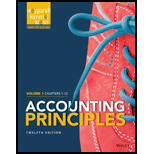
Concept explainers
1.
Sarbanes Oxley Act: Sarbanes Oxley Act was established by the U.S. government to protect the interest of the investors from the companies.
Ethics: Ethics refer to the moral principles and practices that a company shall adopt for the operation of its business.
Securities and Exchange Commission (SEC): SEC is an independent body set up by the U.S. government whose main objective is to protect the investors from any fraudulent activity by the companies.
Historical Cost Principle: The historical cost principle is the concept in accounting which states that the assets should be recorded at the value at which they were purchased
Monetary Unit Assumption: The monetary unit assumption is the concept in accounting that assumes that the events that have a monetary value are the only events that are recorded in the books.
To identify: Whether the given statement is true or false.
Statement: Congress passed the Sarbanes Oxley Act to ensure that investors invest only in companies that will be profitable.
2.
To identify: Whether the given statement is true or false.
Statement: The standards of conduct by which actions are judged as loyal or disloyal are ethics.
3.
To identify: Whether the given statement is true or false.
Statement: The primary accounting standard-setting body in United States is Securities and Exchange Commission.
4.
To identify: Whether the given statement is true or false.
Statement: The historical cost principle dictates that companies record assets at their cost and continue to report them at their cost over the time the assets are held.
5.
To identify: Whether the given statement is true or false.
Statement: The monetary unit assumption requires that companies record only transactions that can be measured in money.
Want to see the full answer?
Check out a sample textbook solution
Chapter 1 Solutions
ACCOUNTING PRINCIPLES V.1 W/ WILEY PLU
- Unearned revenue becomes revenue when:A. A sale is madeB. Cash is receivedC. The service is performedD. The revenue is recordedarrow_forwardWhat is the effect of a debit to an expense account?A. Decreases expensesB. Increases equityC. Increases expensesD. Decreases assetsarrow_forwardIf total debits exceed total credits on a trial balance, the difference is most likely:A. A net lossB. A recording errorC. A net incomeD. An overstatement of assetsarrow_forward
- Which of the following accounts would be found on the post-closing trial balance?A. Service RevenueB. Salaries ExpenseC. Retained EarningsD. Dividendsarrow_forwardNeed answer What type of account is Service Revenue?A. AssetB. LiabilityC. EquityD. Revenuearrow_forwardNo chatgpt What type of account is Service Revenue?A. AssetB. LiabilityC. EquityD. Revenuearrow_forward
- No chatgpt Which of the following would be found in the investing activities section of the cash flow statement?A. Cash received from issuing sharesB. Cash paid for dividendsC. Cash paid for new equipmentD. Cash received from customersarrow_forwardWhich of the following would be found in the investing activities section of the cash flow statement?A. Cash received from issuing sharesB. Cash paid for dividendsC. Cash paid for new equipmentD. Cash received from customersno aiarrow_forwardWhich of the following would be found in the investing activities section of the cash flow statement?A. Cash received from issuing sharesB. Cash paid for dividendsC. Cash paid for new equipmentD. Cash received from customerhelo mearrow_forward

 AccountingAccountingISBN:9781337272094Author:WARREN, Carl S., Reeve, James M., Duchac, Jonathan E.Publisher:Cengage Learning,
AccountingAccountingISBN:9781337272094Author:WARREN, Carl S., Reeve, James M., Duchac, Jonathan E.Publisher:Cengage Learning, Accounting Information SystemsAccountingISBN:9781337619202Author:Hall, James A.Publisher:Cengage Learning,
Accounting Information SystemsAccountingISBN:9781337619202Author:Hall, James A.Publisher:Cengage Learning, Horngren's Cost Accounting: A Managerial Emphasis...AccountingISBN:9780134475585Author:Srikant M. Datar, Madhav V. RajanPublisher:PEARSON
Horngren's Cost Accounting: A Managerial Emphasis...AccountingISBN:9780134475585Author:Srikant M. Datar, Madhav V. RajanPublisher:PEARSON Intermediate AccountingAccountingISBN:9781259722660Author:J. David Spiceland, Mark W. Nelson, Wayne M ThomasPublisher:McGraw-Hill Education
Intermediate AccountingAccountingISBN:9781259722660Author:J. David Spiceland, Mark W. Nelson, Wayne M ThomasPublisher:McGraw-Hill Education Financial and Managerial AccountingAccountingISBN:9781259726705Author:John J Wild, Ken W. Shaw, Barbara Chiappetta Fundamental Accounting PrinciplesPublisher:McGraw-Hill Education
Financial and Managerial AccountingAccountingISBN:9781259726705Author:John J Wild, Ken W. Shaw, Barbara Chiappetta Fundamental Accounting PrinciplesPublisher:McGraw-Hill Education





